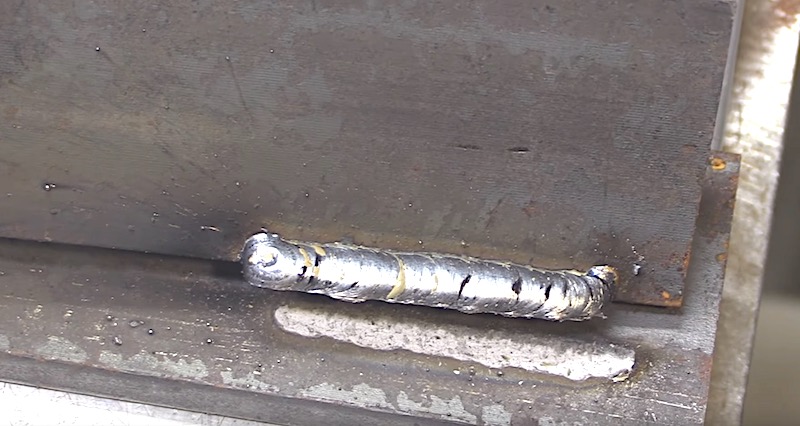MIG Welding Fillet Welds in Flat and horizontal positions 1F, 2F
This page is about MIG Welding Fillet Welds in the Flat and horizontal positions (1F and 2F) on Tee joints, lap joints, and outside corner joints
Tee joints, lap joints, and outside corner joints are the 3 most common joints for fillet welds.
For short circuit mig welding, the keys to making a good quality fillet weld are:
- Remove thick mill scale
- Use a short stick out also called ctwd for contact tip to work distance.
- Whether using a push or pull angle, limit gun angle
- Use a technique that moves the arc to the leading edge of the puddle
- Use proper settings
First lets take a look at the first point…
#1 Remove thick mill scale.

Short circuit mig is a good welding process but one limitation is that it doesn’t penetrate through thick mill scale nearly as well as spray transfer mig, dual shield flux core, or stick.
Not all mill scale is the same thickness.
For example 2 inch Square tubing usually has a very thin layer of mill scale and can easily be welded using short circuit mig.
But thick hot rolled bar stock, plate and other shapes usually have a very thick layer of mill scale that should be removed.
#2 Use a short stick out also called CTWD for contact tip to work distance.
The terms CTWD and Stickout are interpreted differently by some people but to me, they are the same thing...
…the distance between the contact tip and the weld puddle.
With short circuit mig, using too long a stickout causes lots of problems like lack of penetration, excess spatter, and ropey beads.
#3 Limit the gun angle.
Whether you push or pull (both work) limiting gun angle will help avoid excess spatter and other undesirable things like lack of fusion and excess convexity.
The pushing vs pulling gun angle discussion seems to never end but after doing hundreds of break tests and cut and etch tests, I am convinced that either pushing or pulling works fine if gun angle is not out of scope....one test is worth a thousand opinions.
Remember, we are strictly talking about short circuit mig here.
For spray transfer, pushing generally works better.
#4 Use a technique that plays the arc to the leading edge of the puddle.
I like to use techniques that manipulate the arc in such a way that the arc traces the leading edge of the puddle in some way.
The main tech techniques I use to accomplish this on flat and horizontal fillet welds are a series of cursive E’s or U’s, or a series of sideways V’s.
Both techniques are shown in the video on this page
#5 Use proper settings.
But what are the proper settings?
Fortunately, most reputable mig machine manufacturers put a chart inside the wire feeder door and it helps in getting your settings in the ball park for fillet welds.
But For overhead and vertical uphill welding, along with lots of other specific welds, MIG chart settings are not that much help.
But good news, I have a FREE MIG Cheat code download that not only shows 11 of the most common fillet welds, but also has links that take you to short videos that show settings and techniques.
Its completely free to download and share with anyone you want.
… Along with the MIG cheat code pdf, you will also get my MIG mini course in 4 emails that will give you a great jump start and help you get past the frustration points of vertical uphill and overhead mig welding.













